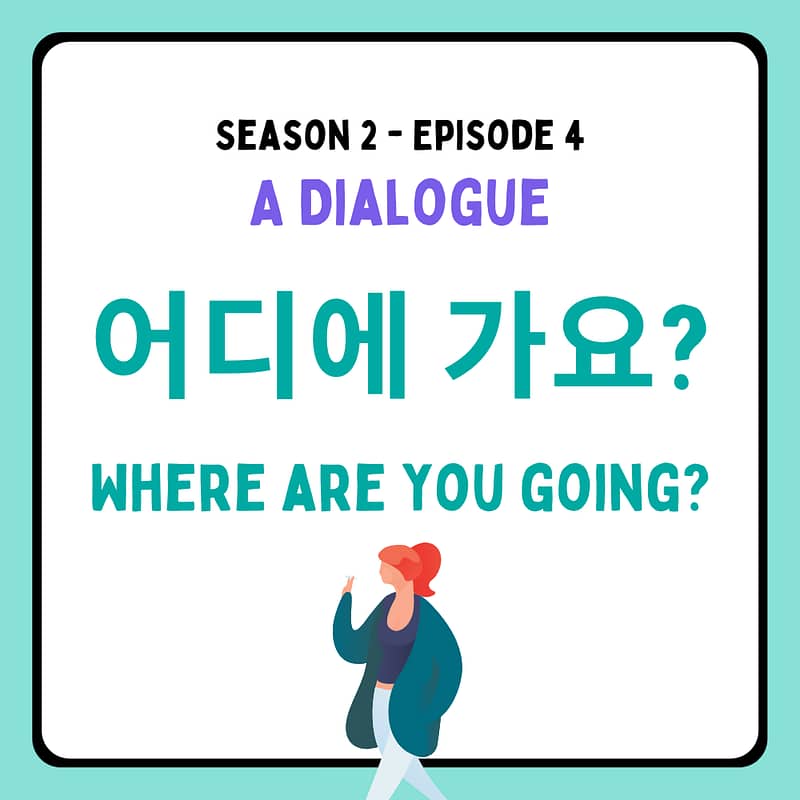Powered by RedCircle
시즌2, 4화. 대화편 | 어디에 가요?
Season 2, Episode 4, A dialogue | Where are you going?
Hello! 잘 지냈어요? How have you been?Today we will listen to a dialogue written by Korean Study Café. If you want to check out the transcript with the translation, visit the Korean Study Café website at Koreanstudycafe.com/podcast.Today's episode was made based on a request from our Instagram friend named "Dorsa" from Iran. Then now, shall we listen to the dialogue?
C: 바네사 씨 안녕하세요?
Hello Vanessa
V: 안녕하세요? 크리스 씨. 오랜만이에요.
Hi Chris, It has been a while.
C: 네. 그러니까요. 바네사 씨, 어디로 가요? 차로 데려다 줄게요.
Yes, it sure has been. Vanessa, where are you head to? I will drop you off.
V: 아, 정말요? 저는 지금 이태원으로 가는 길이었어요.
Oh really? I was on my way to Itaewon as well
C: 아, 그래요? 저도 마침 이태원 쪽으로 가고 있어요. 그럼 데려다 줄게요.
Oh yeah? I also was heading towards Itaewon. I’ll drop you off.
V: 우와, 정말 감사합니다.
Wow, Thank you so much.
….
C: 어디에 가는 길이었어요?
Where were you going?
V: 네, 집에 가고 있었어요. 집이 이태원에 있어요.
I was heading home. My home is in Itaewon.
C: 아, 그래요? 저도 이태원 근처에 살아요. 보통 퇴근 후에 집에서 뭐 해요?
Oh, really? I also live near Itaewon. What do you usually do at home after work?
V: 음… 보통 집에서 요리하고 청소하고 TV도 봐요. 그리고 강아지하고 산책도 해요.
Well, I usually cook, clean and watch TV at home. Also, I go for a walk with my dog.
C: 아, 집에 강아지가 있어요?
Oh, you have a dog at home?
V: 네, 낮에는 강아지가 보통 혼자 있어서 저녁에는 같이 놀아줘야 돼요.
Yes, the dog is usually alone during the day, so I have to play with him in the evening.
C: 아, 그렇군요. 그럼 낮에 강아지는 집에서 혼자 뭐 해요?
Oh, I see. So what does the dog do alone at home during the day?
V: 음… 간식도 먹고 낮잠도 자요. 그런데 보통 집에서 혼자 저를 기다려요.
Well, (he) eats snacks and takes naps. But usually at home alone, (he) waits for me.
C: 아, 그러면 강아지가 많이 심심하겠어요.
Oh, then the dog must be very bored.
V: 네, 맞아요. / 아, 여기쯤 세워주세요. 데려다주셔서 감사합니다.
Yes, Oh, please stop here. Thanks for the ride.
C: 아니에요. 그럼 바네사 씨, 다음에 또 만나요~ 안녕히 가세요!
Don’t mention it. Then, see you next time, Vanessa. Goodbye!
V: 네, 안녕히 가세요~
Yes, good bye
Okay, We heard a dialogue that took place while Chris drove Vanessa home.
Many good expressions are helpful to apply to the actual situation. Then now, shall we break down the dialogue together?
바네사 씨 안녕하세요?
안녕하세요? 크리스 씨. 오랜만이에요.
네. 그러니까요. 바네사 씨, 어디로 가요? 차로 데려다 줄게요.
아, 정말요? 저는 지금 이태원으로 가는 길이었어요.
아, 그래요? 저도 마침 이태원 쪽으로 가고 있어요. 그럼 데려다 줄게요.
우와, 정말 감사합니다.
It seems like they bumped into each other in a street where Chris was driving his car, and Vanessa was walking along a pedestrian road.
Chris asked “어디로 가요?” Where are you heading to? He wanted to know the direction to where Vanessa was heading towards. If he wanted to know the destination, then he would’ve asked like 어디에 가요? Where are you going?
Vanessa answered, “이태원으로 가는 길이었어요” I was on the way to go to Itaewon. Then Chris replied that 저도 마침 이태원 쪽으로 가고 있어요. I am on my way to Itaewon as well. Here to state the direction that they go, they kept using a preposition 으로 or 로. Since they just wanted to express their direction generally, they used this preposition 으로 or 로. 으로 is paired with the words ending with 받침 whereas 로 should be paired with the words ending without 받침.
So if they wanted to state their destinations precisely, they would’ve used a more specific destination with a different direction preposition which is 에 and the sentences would’ve been like this. 집에 가는 길이었어요 or 이태원역에 가고 있어요. But if you want to use the word 쪽, which means side or direction, you cannot use 에 prepositions because these words’ meanings conflict with each other.
All right, then now let’s hear the next part
어디에 가는 길이었어요?
네, 집에 가고 있었어요. 집이 이태원에 있어요.
And this was an excellent part to see all usages of 에. Chris asked, 어디에 가는 길이었어요? Where were you going? Vanessa answered, 집에 가고 있었어요. I was going to my house. 집이 이태원에 있어요. My home is in Itaewon. Here, we use 에 to express the destination and the location of a person or animal or thing. So in the sentence 집에 가고 있었어요, 에 here is used for explaining the destination, while 에 from 집이 이태원에 있어요 is used for expressing the location of a person or a thing. And now let’s hear the next part
아, 그래요? 저도 이태원 근처에 살아요. 보통 퇴근 후에 집에서 뭐 해요?
음… 보통 집에서 요리하고 청소하고 TV도 봐요. 그리고 강아지하고 산책도 해요.
And Chris said 저도 이태원 근처에 살아요. I also live near Itaewon, and he asked another question which was 보통 퇴근 후에 집에서 뭐 해요? What do you usually do at home after leaving work? 퇴근 means leaving work. Then what would be the word for saying going to work? Yes, that’s 출근. If you want to use these expressions as verbs, just simply add 하다 to do. Many expressions work like this in Korean. 하다 is a magic verb.
Anyways, back to the last sentence. 집에서 뭐 해요? Then here, why Chris used 에서 instead of 에. That’s simple. If the location noun is where some action or behavior occurs, we have to use this preposition 에서. For example, 집에서 숙제를 해요 I do my homework at home, 도서관에서 책을 읽어요 I read books in a library. 카페에서 커피를 마셔요 I drink coffee at a coffee shop.
And the following sentence is also an excellent example to show this. 보통 집에서 요리하고 청소하고 TV도 봐요. I usually cook, clean, and watch TV at home. As you see, these are all actions or somewhat related to movement. So 에서 should be used in this sentence.
All right, then since we know the difference among 으로/로, 에, 에서, let’s hear the rest part while keeping that in our mind.
아, 집에 강아지가 있어요?
네, 낮에는 강아지가 보통 혼자 있어서 저녁에는 같이 놀아줘야 돼요.
아, 그렇군요. 그럼 낮에 강아지는 집에서 혼자 뭐 해요?
음… 간식도 먹고 낮잠도 자요. 그런데 보통 집에서 혼자 저를 기다려요.
아, 그러면 강아지가 많이 심심하겠어요.
아, 집에 강아지가 있어요? Do you have a dog at home? Here 에 is simply indicating a location, right? On the other hand 강아지는 집에서 혼자 뭐 해요? What does the dog do alone at home? We had to use 에서 because the verb is stating an action 하다 to do.
All right. So Vanessa said overall, as her dog stays at home alone during the daytime, she has to play with the dog after getting home. Because what the dog does during the daytime is just waiting for her.
Those who have a dog can be relatable for this part. Even if they have many toys, they don’t have fun with the toys alone. They always wait for their owners until they come back.
So Chris said 그러면 강아지가 많이 심심하겠어요 Then the dog should be very bored. 심심하다 means “to be bored “겠어요 is an ending that means “should be or must be” with a guessing tone.
Okay, now it’s our last part. Shall we listen to the final part?
네, 맞아요. 아, 여기쯤 세워주세요. 데려다주셔서 감사합니다.
아니에요. 그럼 바네사 씨, 다음에 또 만나요~ 안녕히 가세요!
네, 안녕히 가세요~
여기쯤 세워주세요. 여기쯤 around here 세워주세요 stop for me. The verb 세우다 has many meanings, but it means “to stop a vehicle or a machine” in this part. And this verb is combined with a suffix 주다. If 주다 is combined with other verbs, then it has a nuance “for someone.” So the expression 여기쯤 세워주세요 means stop the car around here for me.
And 데려다주셔서 감사합니다. Thank you for taking me home. It’s an excellent expression to use for the actual conversation. So try to remember it.
And lastly, why do these two people say 안녕히 가세요 to each other? Usually, it should be like when one person says 안녕히 가세요; then the other person should say 안녕히 계세요, right? Haha, That’s actually not always true.
When people are being separated to other locations/directions, people can say 안녕히 가세요 to each other in this kind of situation.
So this is it for today. I hope this dialogue example helps your speaking skills in Korean improve. So if you want to check out the transcript of today's episode, please visit koreanstudycafe.com/podcast.Also, we upload some grammar points and expressions related to this topic on our Instagram "koreanstudycafe.official" and our Twitter and Facebook "koreanstudycafe."Also, if you have any questions or suggestions, feel free to contact us using any social media platform or directly through our website.그럼 오늘도 들어주셔서 감사합니다. Thank you for listening today—다음에 또 만나요. See you again soon. 안녕~~~!



